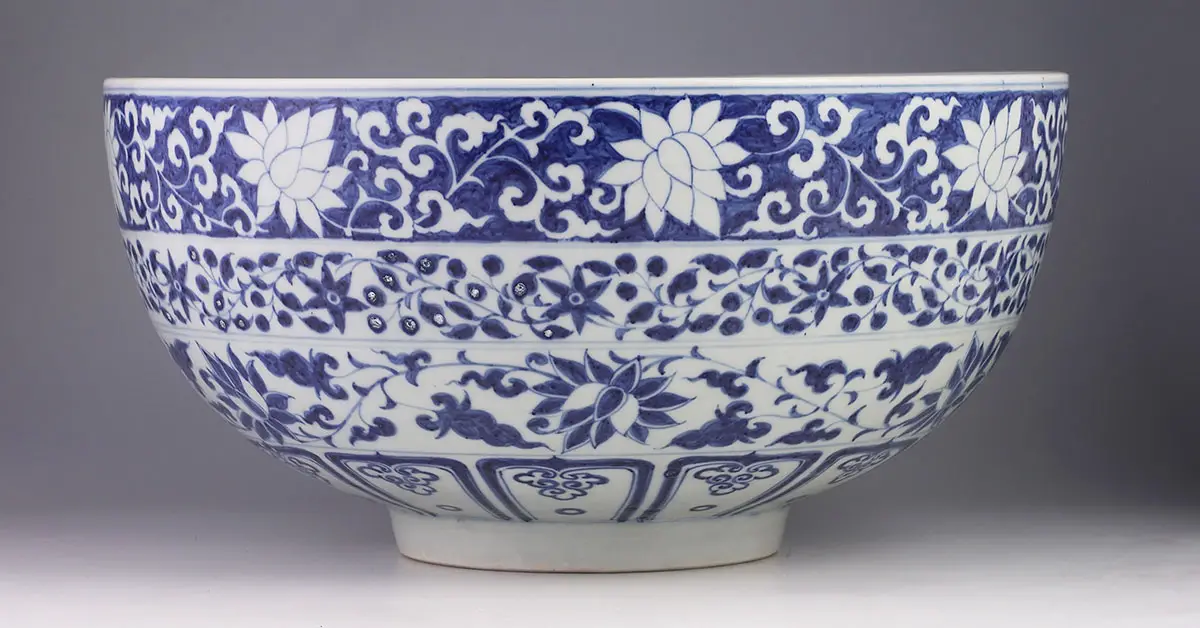When it comes to yard sales, another man’s trash is another man’s treasure. However, in this case, the yard sale sold a bowl for $35 that turned out to be a rare, 15th-century Chinese porcelain artifact worth up to $500,000. The “exceptional and rare” bowl will be part of the Sotheby’s Important Chinese Art auction in New York on March 17.
“It was immediately apparent to both of us that we were looking at something really very, very special,” said Angela McAteer, about when she examined the bowl with house expert Hang Yan. McAteer is Sotheby’s senior vice-president and head of its Chinese Works of Art Department. “The style of painting, the shape of the bowl, even just the color of the blue is quite characteristic of that early, early 15th century period of porcelain.” [1]
Yard-Sale Bowl Is Worth Half a Million Dollars
The unaware buyer didn’t haggle for the asking price of $35. Afterward, the unnamed man in Connecticut emailed photos of the bowl to Sotheby’s for an evaluation. He must’ve been shocked when the appraisers dated it back to the Ming dynasty in the 1400s. It was worth from $300,000 to half a million.
“It’s always quite astounding to think that it kind of still happens, that these treasures can be discovered,” said McAteer. “It’s always really exciting for us as specialists when something we didn’t even know existed here appears seemingly out of nowhere.” [2]
The yard-sale bowl is about 6 inches wide with a lotus bud shape. It was decorated with cobalt blue “blossoms of lotus, peony, chrysanthemum, and pomegranate flowers” and “bordered by a band of lotus scrolls around the rim,” with a medallion at the bottom. Only six bowls like this exist. One is in the National Museum of Iran in Tehran; two are at the National Palace Museum in Taipei, Taiwan, and two more are in museums in London, England — the British Museum and the Victoria and Albert Museum.
Porcelain From the Ming Period
McAteer notes that the artifact contains “all the characteristics and hallmarks” from the early Ming period, from the distinct design and color to the smooth finish. The experts at Sotheby’s believe it was made during the reign of the Yongle Emperor from 1403 to 1424. At that time, the style of porcelain work was “immediately recognizable, never surpassed, and defining the craft still in the eighteenth century,” according to experts McAteer and Yin.
In that era, the court controlled every facet of porcelain from the imperial kilns, from the creation to the distribution. Meaning, porcelain wasn’t traded in the usual markets to the east, Middle East, and Africa. Larger pieces were sold to other countries, but small ones like the bowl were kept in the palace’s collection, where they are mostly found nowadays.
Frequently, the court destroyed or buried copies of a piece so others couldn’t duplicate them. That is why very few “companions” to the yard-sale bowl still exist. However, the story of how it came to Connecticut centuries later is not known. [3] It is speculated that it became an heirloom in a family unaware of its true value.
“The Artistic Importance of Porcelain”
Reads the catalog note, “In every respect, this delicate bowl is a quintessential Yongle product, made for the court, showing the striking combination of superb material and painting with a slightly exotic design that characterizes imperial porcelain of this period.”
Despite its ancient history, including ending up at a yard sale, the bowl is in “overall very good condition,” aside from a bit of warping at the rim and a shallow chip. However, the signs of some wear and firing imperfections are considered to be “all consistent with age and type.” [4]
Nowadays, pottery from the Ming dynasty is extremely valuable. In 2014, a bowl from the 15th century with the distinctive Ming-style won $36.3 million at auction (about $40 million when accounting for inflation).
“The Yongle Emperor really promoted the artistic importance of porcelain,” McAteer said. “He elevated it from being a utilitarian bowl, for example, into a true work of art.” [5]
Keep Reading: Poor Fisherman Finds Extremely Rare Pearl Worth $330,000 While Searching for Food
Sources
- “Bowl Bought at Yard Sale for $35 Turns Out to Be Ancient Chinese Artifact That Could Fetch $500K.” People. Rachel DeSantis. March 3, 2021
- “Chinese bowl sold at yard sale for $35 is actually worth up to half a million.” CBC. Dave Collins. March 3, 2021
- “This $35 bowl sold at a Connecticut yard sale is worth $500,000.” Live Science. Yasemin Saplakoglu. March 6, 2021
- “Yard-Sale Bowl Revealed To Be Rare Chinese Artifact Worth Up To $500,000.” NPR. Rachel Treisman. March 3, 2021.
- “Porcelain Bowl Bought at Yard Sale for $35 Could Sell at Auction for $500,000.” Smithsonian Magazine. Isis Davis-Marks. March 1, 2021

